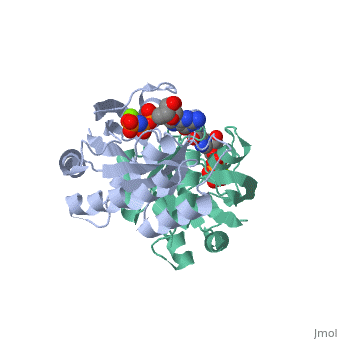Jasper Final Sandbox
From Proteopedia
| |||||||||
| 5p21, resolution 1.35Å () | |||||||||
|---|---|---|---|---|---|---|---|---|---|
| Ligands: | , | ||||||||
| |||||||||
| |||||||||
| Resources: | FirstGlance, OCA, RCSB, PDBsum | ||||||||
| Coordinates: | save as pdb, mmCIF, xml | ||||||||
REFINED CRYSTAL STRUCTURE OF THE TRIPHOSPHATE CONFORMATION OF H-RAS P21 AT 1.35 ANGSTROMS RESOLUTION: IMPLICATIONS FOR THE MECHANISM OF GTP HYDROLYSIS
Contents |
Overview
HRAS is an intercellular GTPase switch protein. It is directly involved with regulating cell growth, and is one of the first steps in the pathway. It has two forms, an active form in which it is bound to GTP and an inactive form in which it is bound to GDP. HRAS is downstream from most RTK's, and the pathway culminates with the activation of MAP kinase. The protein SOS (son of sevenless) is necessary for HRAS to release GDP and become active. The SOS protein binds to a distal and active site on HRAS. It has also been shown that prenylation of SOS is necessary for interactions with HRAS.
Mutations
Mutations in the HRAS can lead to the development of Costello syndrome and bladder cancer. Costello syndrome is a genetic disorder in which infants can be born mentally retarded, commonly with loose folds of skin and very flexible joints. The most common mutation is the replacement of glycine with serine at , although five mutations have been linked to the disorder. The mutation leads to HRAS that is unable to enter the inactive form, and thus leads to uncontrolled cell growth. The mutation of HRAS linked with bladder cancer is also at the same position, , where a valine instead of serine replaces a glycine. Like the mutation in Costello syndrome, this mutation results in HRAS proteins to be constantly on which leads to uncontrolled growth.
About this Structure
The crystal structure of the H-ras oncogene protein p21 complexed to the slowly hydrolysing GTP analogue GppNp has been determined at 1.35 A resolution. 211 water molecules have been built into the electron density. The structure has been refined to a final R-factor of 19.8% for all data between 6 A and 1.35 A. The binding sites of the nucleotide and the magnesium ion are revealed in high detail and consists of a characteristic . For the stretch of amino acid residues 61-65, the temperature factors of backbone atoms are four times the average value of 16.1 A2 due to the multiple conformations. In one of these conformations, the side chain of makes contact with a water molecule, which is perfectly placed to be the nucleophile attacking the gamma-phosphate of GTP. Based on this observation, we propose a mechanism for GTP hydrolysis involving mainly and as activating species for in-line attack of water. Nucleophilic displacement is facilitated by hydrogen bonds from residues , and .
5P21 is a Single protein structure of sequence from Homo sapiens. Full crystallographic information is available from OCA.
Reference
Refined crystal structure of the triphosphate conformation of H-ras p21 at 1.35 A resolution: implications for the mechanism of GTP hydrolysis., Pai EF, Krengel U, Petsko GA, Goody RS, Kabsch W, Wittinghofer A, EMBO J. 1990 Aug;9(8):2351-9. PMID:2196171
Aoki, Y.; Niihori, T.; Kawame, H.; Kurosawa, K.; Ohashi, H.; Tanaka, Y.; Filocamo, M.; Kato, K.; Suzuki, Y.; Kure, S.; Matsubara, Y. : Germline mutations in HRAS proto-oncogene cause Costello syndrome. Nature Genet. 37: 1038-1040, 2005. Pechlivanis M, Ringel R, Popkirova B, Kuhlmann J. Prenylation of Ras facilitates hSOS1-promoted nucleotide exchange, upon Ras binding to the regulatory site
Page seeded by OCA on Sun May 4 22:36:34 2008



